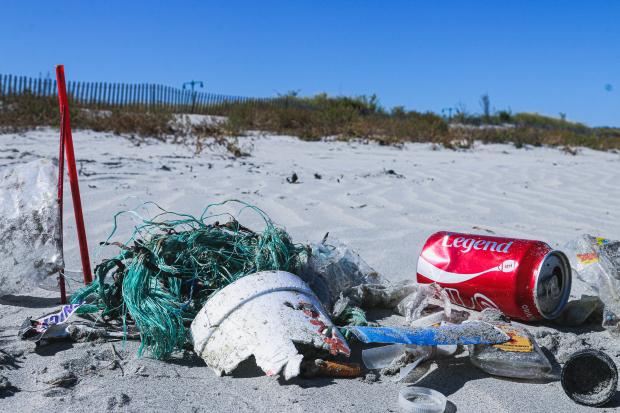PODCAST: COVID-19 Impact on Plastic Pollution

Abstract
When it came to the global shutdowns due to COVID-19, people began to rely on non-reusable plastic to protect themselves from the newest infectious disease – not fully recognizing the detrimental environmental impacts. The increased reliance on plastic use during the pandemic has led to a rise in plastic pollution, and the budget cuts in recycling programs have adversely affected how the environment will recover from plastic pollution. Recent studies demonstrate the underlying effects of microplastic pollution in the environment as well as within human populations. By developing robust environmental policies and bringing light to the situation, the human population can combat the current rise in plastic pollution within our environments before the problem spirals out of our control.
PODCAST: COVID-19 Impact on Plastic Pollution
Remember when fighting against plastic pollution was a trend! With COVID-19, there’s a high demand for surgical face masks, plastic packaging, and disposable utensils1-2. According to a 2020 research study conducted by Mehnaz Shams (et.al), plastic disposal can result in microplastics that become invisible to the naked eye3. Dr. Christian Dunn, a microplastics expert, has stated that single-use plastic can be extremely damaging to the environment and have everlasting effects4. With the pandemic, there’s an increase in plastic use involving PPE and other plastic waste2. A research study, directed by Tadele Aragaw, found that surgical face masks can serve as a probable source of microplastic pollution in water systems1. Additionally, there’s a high demand for single-use plastics due to COVID, leading to an increase in plastic pollution.
In Shams’ study (et.al), due to high densities, the plastics accumulate and settle in water systems which can lead to human consumption through the food chain3. A 2019 research study by Zhichao Wang (et.al), illustrated evidence of metallic substances within microplastics5. Since the pandemic, there has been less focus on plastic pollution and an increase in budget cuts within recycling programs across the world6. Dave Ford, the founder of the environmental literacy organization, SoulBuffalo, and the Ocean Plastics Leadership Network, stated that recycling programs remained as “the last line of defense” in combating plastic in our environments6. Although carbon emissions reduced to about 4% after the several lockdowns around the world due to COVID, there has been a 30% increase of waste creeping into water systems due to a higher dependency on plastic and non-recyclable materials6. Ford states “129 billion face masks are being made every month” and most of these end up in our water systems6. Even though we need to prevent disease transmission, we should still pay attention to the rising of plastic pollution and find alternatives5.
Restructuring environmental policies surrounding PPE and single-use plastic can combat plastic pollution2. Understandably, hospitals tend to utilize more medical plastic. Therefore, people should limit their plastic use by seeking sustainable alternatives. Several countries have taken the initiative to ban or restrict single-use plastic7. In the U.S., cities have banned Styrofoam and plastic straws to lower levels of plastic pollution7. Internationally, the Welsh government has implemented initiatives in promoting re-usable alternatives compared to single-use plastics to combat their environmental impact like increasing the usage of reusable cloth face masks instead of surgical face masks4. We must enact an environmentally conscious society, so humans can foster a safer environment that will last for future generations.
Sources
1. Aragaw TA. Surgical face masks as a potential source for microplastic pollution in the COVID-19 scenario. Marine Pollution Bulletin. 2020;159:111517. doi:10.1016/j.marpolbul.2020.111517
2. Vanapalli KR, Sharma HB, Ranjan VP, Samal B, Bhattacharya J, Dubey BK, Goel S. Challenges and strategies for effective plastic waste management during and post COVID-19 pandemic. Science of The Total Environment. 2020 Aug 4:141514. doi:10.1016/j.scitotenv.2020.141514
3. Shams M, Alam I, Chowdhury I. Aggregation and stability of nanoscale plastics in aquatic environment. Water Research. 2020;171:115401. doi:10.1016/j.watres.2019.115401
4. Flint R. Covid-19: Single-use plastic impact “will last forever.” BBC News. 2020 Sep 26 [accessed 2021 Apr 8]. https://www.bbc.com/news/uk-wales-54265590
5. Wang Z, Qin Y, Li W, Yang W, Meng Q, Yang J. Microplastic contamination in freshwater: first observation in Lake Ulansuhai, Yellow River Basin, China. Environmental Chemistry Letters. 2019;17(4):1821–1830. doi:10.1007/s10311-019-00888-8
6. Mosley T, McMahon S. COVID-19 Pandemic Has Led To More Ocean Plastic Pollution | Here & Now. 2020 Oct 20 [accessed 2021 Apr 7]. https://www.wbur.org/hereandnow/2020/10/12/plastic-pollution-coronavirus
7. A running list of action on plastic pollution. Environment. 2019 Jun 10 [accessed 2020 Sep 11]. https://www.nationalgeographic.com/environment/2018/07/ocean-plastic-pol…
